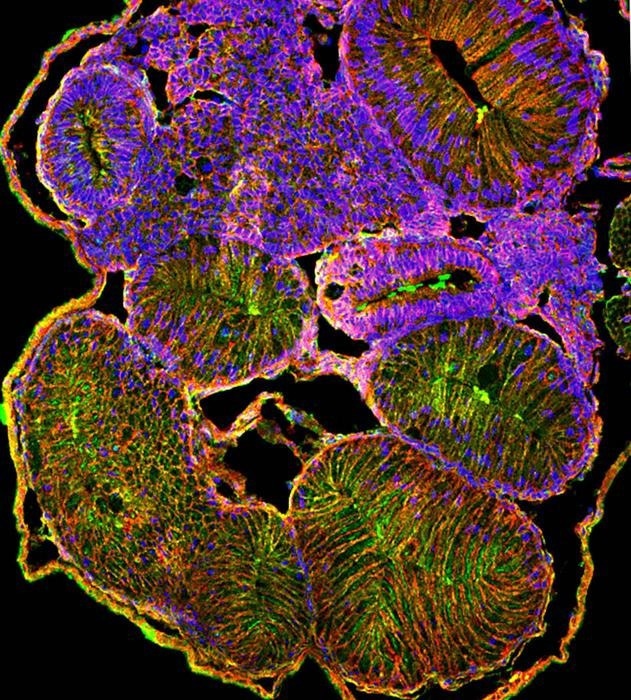Intestines can reach a length of 15 feet or more; how does it fit within human bodies properly? The gut tube dramatically loops and rotates to bundle the extending intestine as the digestive system grows. Intestinal malrotation is a common, but poorly understood, birth defect caused by the failure of the gut to rotate correctly during development.
 A transverse section through the Xenopus Tadpole intersects multiple loops of the rotated intestine. Image Credit: Julia Grzymkowski
A transverse section through the Xenopus Tadpole intersects multiple loops of the rotated intestine. Image Credit: Julia Grzymkowski
Recently, researchers from North Carolina State University have identified a possible cause of this potentially fatal illness in the research published in the journal Development.
One out of every 500 babies is born with intestinal malrotation, however, the underlying causes are not fully known. Scientists must first comprehend intestine rotation during normal development, a difficult process that still confounds biologists, to grasp why gut revolution could go wrong.
The scientific group, under the direction of Dr Nanette Nascone-Yoder, decided to employ a frog's well-established system.
As vertebrates, frogs and humans share a common ancestor and have many similar anatomical features, including an intestine that rotates in a counter-clockwise direction, because frog embryos develop in only a few days and are highly experimentally accessible, they allow us to quickly test new hypotheses about how and why development goes awry during malrotation.”
Dr Nanette Nascone-Yoder, Study Corresponding Author, Department of Molecular Biomedical Sciences, North Carolina State University
Nascone-Yoder said, “Frog embryos develop in a petri dish and are transparent when the intestine is developing, so they can be exposed to drugs or environmental chemicals to screen for substances capable of producing malrotation.”
The herbicide atrazine was one of the substances that the researchers examined. They chose to concentrate on atrazine to learn more about intestinal malrotation after discovering that exposure to it significantly enhanced the frequency at which frog intestines turned in the opposite (clockwise) direction.
The study experimental lead, Dr Julia Grzymkowski, discovered that the frog embryos' metabolism the chemical reactions that supply energy for biological processes was disturbed by atrazine exposure.
A number of cellular processes in the gut were disrupted by a metabolic imbalance in the embryos; cells were unable to divide, develop, or reorganize themselves in a way that would have caused the correct intestinal elongation and rotation.
Although we found that atrazine causes malrotation in frogs, these results do not necessarily mean that this herbicide causes malrotation in humans, because, in our screen, the tadpoles were exposed to 1000-fold higher levels than are typically found in the environment, but our findings do strongly suggest that disturbing the same cellular metabolic processes affected by atrazine, for example, via exposure to other chemicals in the environment and/or genetic variations that affect metabolism, could contribute to intestinal malrotation in humans.”
Dr Nanette Nascone-Yoder, Study Corresponding Author, Department of Molecular Biomedical Sciences, North Carolina State University
The mechanisms underlying intestinal malrotation during fetal development are still being investigated in this work. Also, he said, the team hoping to extend the research.
Our results have provided new avenues to explore the underlying causes of this prevalent birth anomaly. We are now starting to dive deeper into the cellular events that coordinate the complicated process of intestinal elongation and rotation.”
Dr Nanette Nascone-Yoder, Study Corresponding Author, Department of Molecular Biomedical Sciences, North Carolina State University
Source:
Journal reference:
Grzymkowski, J. K., et.al. (2024) Developmental regulation of cellular metabolism is required for intestinal elongation and rotation. Development. doi:org/10.1242/dev.202020